
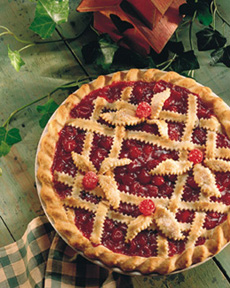
A cherry pie with a beautiful lattice crust. Photo courtesy Cherry Marketing Institute.
June 2009
Last Updated September 2025
|
 |
Pie & Pastry Glossary
The Different Pastry Types
Page 1: Definitions With A
CAPSULE SUMMARY: This is Page 1 of a ten-page glossary of pastry types. Click the black links below to visit other pages. Also see our many other food glossaries, each featuring a different favorite food.
Pastry & Pie History
While the French have the reputation as the great pastry makers, the Egyptians, who were great bread bakers, worked out the details of early pastry. Theirs was a savory pastry: a dough of flour and water paste to wrap around meat and soak up the juices as it cooked.
Pastry was further developed in the Middle East and brought to Mediterranean Europe by the Muslims in the 7th century. Another leap occurred in the 11th Century when Crusaders brought phyllo dough back to Northern Europe (the First Crusade was from 1096 to 1099). Greek and Roman pastry did not progress as far as it could have because both cultures used oil, which couldn’t create a stiff pastry.
In medieval Northern Europe, the traditional use of lard and butter instead of oil for cooking hastened the development of other pastry types. Pies were developed, and the stiff pie pastry was used to provide a casing for the various fillings. By the 17th century, flaky and puff pastries were in use, developed by French and Italian Renaissance chefs, and pastry began to become highly decorated, with pastry chefs working intricate patterns on the crusts.
National Pie Day, January 23rd, is an annual celebration of pies started in the mid-1970s by a nuclear engineer in Boulder, Colorado, named Charlie Papazian. He declared his own birthday, January 23rd, to be National Pie Day. Since 1986, National Pie Day has been sponsored by the American Pie Council.
ALMOND CROISSANT
A sweet croissant filled with almond paste and topped with sliced almonds. Some are dusted with confectioners’ sugar. As such, it becomes more of a pastry than a bread.
ALMOND TART
A tart filled with almond paste.
ALMOND PASTE and MARZIPAN
Almond paste is made of blanched, finely ground almonds, powdered sugar, and, generally, glucose or syrup to bind them together. It is coarser and less sweet than marzipan. Both are used as a pastry filling, and were traditionally popular in wedding cakes as a layer on top of the cake and under the fondant.
Marzipan has more sugar and is also shaped into plain or chocolate-covered rolls, painted figures, and fruits, and enjoyed directly as a confection. Marzipan originated in the Middle East, where it was flavored with rose water or orange blossom water. The delicacy was served at palaces as early as 965 C.E.
While scholars don’t agree as to the origin of the word, one explanation is that it is a combination of the Arabic “mautaban” and the Italian “Marci panis,” meaning Marcus bread.*
Marzipan came to Europe via the Arab invasion of Spain and, like chocolate, was initially a delicacy reserved for monarchs and aristocrats. It was initially produced by pharmacists, who had the spice monopoly.
In the 19th century, when sugar became affordable to most people, it entered the confectionery mainstream. While modern European countries regulate the ratios of sugar to almonds that define marzipan and almond paste, these do not exist in the U.S. Because the ratios can vary significantly, try different brands to see what you like.
_______________
*Mautaban meant “sitting king” in Arabic (as costly marzipan was initially a food for regents), a Byzantine coin (with the image of the king), and also, apparently, a box in which marzipan was traded. Marci pani, “Bread of Marcus,’ refers to Saint Marcus, the patron saint of bakers. There are numerous other explanations.
|
|
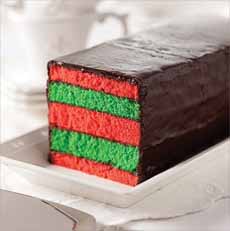
Marzipan loaf cake. Photo courtesy Mackenzie Ltd.
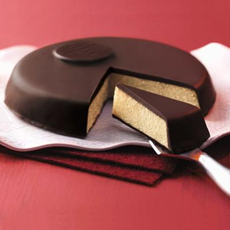
Marzipan torte. Photo courtesy Niederegger.
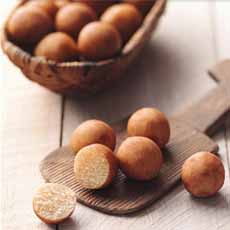
Balls of marzipan decorated to look like potatoes. Photo courtesy Lubeck.
|
À LA MODE
This French term, which means “in the manner (or mode) of,” refers to the style in which a dish is prepared.
For example, “Tripe à la mode de Caen,” a classic French dish, refers to the way tripe is prepared in the Normandy city of Caen (onions and carrots are layered on the bottom of a casserole, topped by a halved steer’s foot, followed by the tripe, garlic, leeks, and herbs, covered with apple cider and Calvados, baked under a crust and served cold).
However, in America, the term has been Americanized, first to mean pie topped with ice cream, and now to mean any dessert with a scoop of ice cream.
|
|
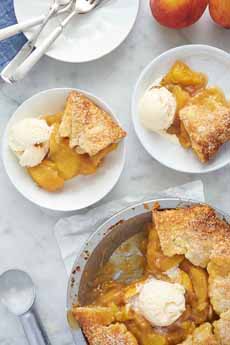
Peach pie à la mode. Photo courtesy King Arthur Flour.
|
ANGEL PIE
Angel pie has a meringue crust filled with whipped cream or pudding. It can also have a layer of fruit filling such as lemon curd, fresh halved strawberries, or whole raspberries, topped with more whipped cream. The pie originated back in the 1930s, a riff on a pavlova.
It is not easy to cut through the meringue to make neat slices, but the combination of meringue pieces and the filling is delicious. Use a large serrated knife/bread knife.
|
|
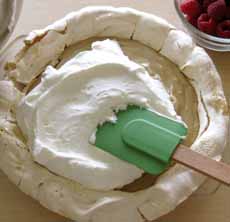
Angel pie. Here’s the recipe from Land ’O Lakes.
|
|
APPLE BROWN BETTY
See brown betty.
APPLE PIE
Forget “as American as apple pie”; the apple pie, in its flour and lard crust, came from England. The sugar, cinnamon, and nutmeg that are essential ingredients were brought by trading ships to England, long before the American Colonies developed—in fact, they came from what would become British colonies. The pie itself was an English pastry specialty, as opposed to the pastry specialties of other cuisines—the French tart and the Greek phyllo pastry, for example.
|
|
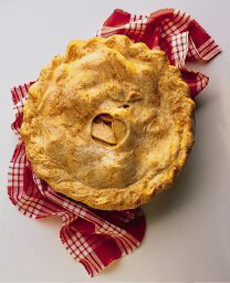
It’s as British as Apple pie. Photo courtesy of Wisconsin Milk Media Board. |
Continue To The Next Page: Terms With B
Go To The Article Index Above

|










